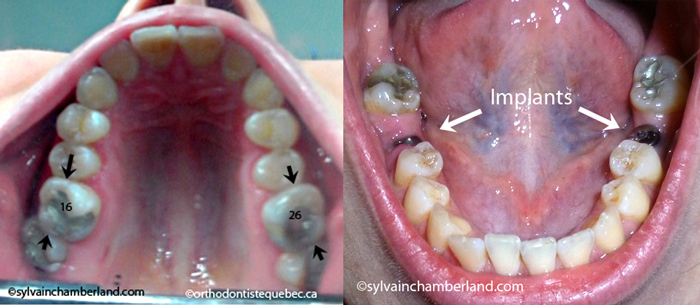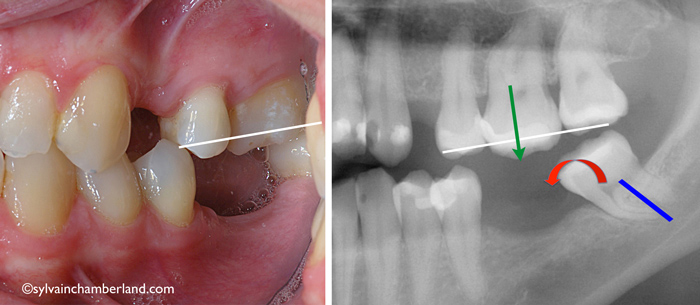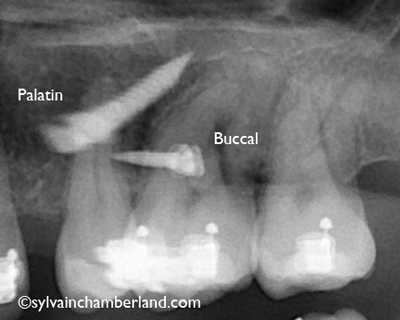Anchorage miniscrews_case report
Question :

Hello,
Your forum is very interesting and I learn a lot.
I am 23 years old and two of my lower molars are missing, which were replaced after 6 years (I am in the osseointegration period).
The problem is that with time, the upper molars have egressed and I now have to find a solution.
From what I could see, either I grind them down, either I pull them up using anchorage miniscrews (mini implants) with elastics.
What would be the solution and would I need to wear a dental appliance with these so-called miniscrews?
I have no idea how much it could cost.
Thank you.
Kimber
Pictures of Kimber’s mouth:
Intraoral pictures

The implants are indicated by the white arrows. Egressing teeth #16 and #26 show a vertical shift with their respective nearby teeth as indicated by the black arrows.
Panoramic X-ray

Dental mutilation of the lower first molars. Hypereruption (egression) of the upper first molars (white arrows).
Réponse :
Your situation is thus the following.
You lost 2 lower molars at around 17 years of age.
6 years later, you started replacing these teeth by osteointegrated implants. These implants were recently installed. The opposing upper molars have erupted (egressed) in the toothless space in the lower arch and negatively affect the future restoration on the lower implants.
The consequences of mutilating lower first molars are described in the Collapse of the vertical dimension page and admirably well illustrated by Case 1: dental mutilation of #36 and #46. In summary, if you do not replace your missing teeth now, all your teeth will move and spaces could be created between the upper teeth even if you do not lose any teeth in the upper maxilla.
This would be quite bad, mostly for someone like you who underwent an orthodontic treatment at an earlier age. I see on the X-ray that you published that large cavities on the upper second molars, which are very visible, are now repaired since we can see large amalgam fillings on your intraoral pictures.
I do not think that grinding your molars is a good solution, because we would have to grind down close to 2 mm of teeth. It is almost as thick as the enamel.
Let’s continue analyzing your problem.
Similar case
Your situation can thus be compared to the situation on the figure below.

The upper molar hypererupted or egressed (green arrow) in the toothless space in the lower arch and goes beyond the upper occlusal plane (white line). The lower molar probably tilted forward (red curve arrow) and its axis is tilted or in mesioversion (blue bar).
You question the fate of your 2 egressed teeth whereas you already have 2 osteointegrated implants where teeth #36 and #46 used to be located.
I think that your dentist did not plan this well. He should have requested the ingression of the upper first molars at best before installing the implants, or at worst simultaneously with the osseointegration period. Moreover, as the second molars are free to continue tilting until you are ready to have the crowns installed, it compromises the making of the crowns that have an ideal width.
For your case, my recommendation is to ingress the upper teeth and, at a minimum, insert stabilizing segments to avoid seeing your second molars tilt even more. Ideally, they should even be straightened.
Example of treatment
Let’s continue describing the treatment of the above example.

8-mm Vector TAS anchorage miniscrews.

Anchorage miniscrews. The miniscrews are inserted between teeth and must not be in contact with the roots.
Two 8-mm Vector TAS anchorage miniscrews were inserted, one on the palatal side and the other one on the buccal side. Special care must be taken to position the miniscrews between the roots. Elastomeric chains attach the tooth to the miniscrews and apply an ingression vertical force.
The following picture presents the final restorations on an implant of the aforementioned example. Notice that the leveling of the occlusal plane obtained with the intrusion (ingression) of the upper first molar and the uprighting of the lower molar. The toothless spaces were planned in a way to obtain an ideal width and height for the restorations (crowns). This whole work will make it possible to maintain an optimal oral health and hygiene.

Ask a question or leave a comment (0)